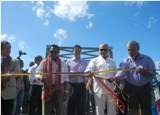Inauguration of Mola Bridge in Zumalai-Covalima

The Head of State, José Ramos-Horta, accompanied by the Prime Minister, Kay Rala Xanana Gusmão, the Minister of Infrastructure, Pedro Lay, the President of the National Parliament, Fernando Lasama de Araújo, and the Ambassador of Japan to Timor-Leste Iwao Kitahara, inaugurated the Mola bridge, in the Zumalai sub-district, Covalima, on July 29.
The bridge is 216 meters long, cost about nine million dollars and was constructed by the Japanese company Dai Nippon Construction (DNC). The work began in January 2010 and was completed in July 2011.
"The bridge is a strategic tool for development and industry and will benefit the communities of Timor-Leste and the neighboring Nation, Indonesia. If our economy is dynamic and stable, our friends who live in Atambua, Indonesia, will also benefit because trade among neighboring communities can be developed. The relationship between Timor-Leste and Indonesia will improve as well the border policy. Therefore, the inauguration of the Mola Bridge is a positive step towards the normalization of economic activities in this district." said President José Ramos-Horta, in his speech.
The Minister of Infrastructure, Pedro Lay, thanked the Government of Japan "on behalf of the Timor-Leste Government, particularly from the Ministry of Infrastructure’s part, for the construction of this bridge, which will improve Timor-Leste’s infrastructure" .
The Ambassador of Japan in Timor-Leste, Iwao Kitahara, considered that "the construction of Mola Bridge is one more symbol of friendship between the peoples of Timor-Leste and Japan. The Government and people of Japan have provided nine million dollars for the construction of Mola Bridge."
Iwao Kitahara also expressed his "thanks for the combined efforts and patience maintained during the construction process. Today we are gathered here for the opening ceremony of the Mola Bridge, which I hope will contribute to improving the quality of living and increase movement between cities, facilitating the transport in the border areas, to give better access to local markets, health and education."










































